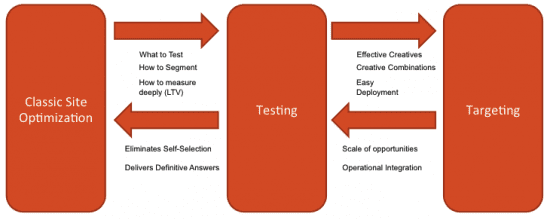Three paths to digital marketing optimisation
Today, many companies are working on conversion improvement, but without an overall strategy which joins the different approaches together as part of an overall conversion strategy. The tools available in our toolbox break down into three, often used individually, but increasingly used together:
- Classic site analytics - Uses web analytics tools, site feedback tools and analysis of behaviour to find problems and suggest fixes
- A/B and MV Testing - AB and multivariate testing which test multiple experiences including both pages and paths to see which is best
- Personalisation - Providing relevant recommendations through targeting rules or algorithms (overlaps with email sequences)
I see these three approaches as paths on the journey to site optimisation often intersect and are complementary. Each can facilitate the more effective use of the others. But while these three paths to optimization should be complementary, they are mostly deployed in a siloed manner that keeps each discipline working sub-optimally.
For each of the three paths, I think it's important to see how each discipline potentially fits into a larger Digital Optimization strategy and understand their strengths and weaknesses. You can see it's not difficult to think of challenges with each of three approaches

Let's take a look at each of the approaches in more detail:
1. Classic Site Optimization (Web analytics) is great for identifying site problems, finding and defining customer segments, and measuring "deep" metrics like Lifetime Value or Engagement. On the other hand, classic Web analytics has great difficulty in controlling for self-selection; this makes it rather poor at choosing between creative alternatives. It's also pretty hard to do and takes significant expertise.
2. Site Testing, on the other hand, provides truly definitive answers between creative versions. It eliminates most self-selection and control issues (at least if done well), it's pretty easy to do, and it generates consistent value. On the other hand, Site Testing methods have little or no ability to identify promising test areas, identify good customer segmentations or support "deep" success metrics. Site testing also can be difficult to scale. Every experiment needs new creative - making the use of micro-segmentation almost impossible.
You should be using Web analytics to figure out what to test and to generate your segmentation (as I've written before, all tests should be segmented). Classic Web Site analytics is also the best way to develop and sustain the "deep" metrics you may need to understand true lift in both Testing and Targeting.
3. Personalization is yet another, and very different, beast. Like Testing, it can eliminate most self-selection and control problems. Unlike Testing, it can scale and take advantage of micro-segmentation. It's generally limited to problems that don't require deep creative and, depending on the approach, it either lacks segmentation or provides a black-box solution to segmentation.
Here's how I see the 3 paths working together:

It's apparent that the strengths of classic Web analytics are a perfect complement to Site Testing and Personalization. It should also be obvious that there is a much bigger role for Site Testing in the development of Personalization than is commonly realized.
You can get around the scale limitation of Testing by focusing on tests of personalization rules. This is a completely different way to think about Testing, but it makes it possible to develop powerful "white-box" approaches to targeting and have a truly logical, integrated path to Targeting and personalization.
This isn't to say that every aspect of Web analytics, Testing or Personalization can or should be integrated. Web analytics has many functions that are simply unrelated to testing. If you need to measure before and after site re-designs, measure the absolute performance of a tool (such as internal search), measure campaign performance, and much more, Web analytics on its own is fine.
Likewise, Testing of Landing Pages often has no necessary or even desirable path or integration to Targeting and Personalization. There are many creative tests that don't lead directly to Personalization or micro-segmentation.
Towards an integrated approach to conversion strategy
Still, to really get full value from each of these components, you need the type of integrated approach I've outlined.
As we at Semphonic see it, Behavioral Use-Case Analysis provides the perfect bridge between classic Web analytics and testing. It creates a digital segmentation, a framework for testing, and a set of likely test targets. It's the perfect way to answer the "where to test" and "how to segment" questions.
Functionalism then provides a more detailed drill-down into the individual performance of site components. This is an excellent method for answering the "what to test" question within the context of a Use-Case and Segment.
Our Two-Tiered Segmentation provides a ready-made integration of traditional visitor segmentation and digital visit types. This is just what's needed to identify personalization options worth testing.
 Thanks to Gary Angel for sharing their advice and opinions in this post. Gary is Co-Founder and President of Semphonic, the leading independent web analytics consultancy in the United States. Gary blogs at SemAngel.
Thanks to Gary Angel for sharing their advice and opinions in this post. Gary is Co-Founder and President of Semphonic, the leading independent web analytics consultancy in the United States. Gary blogs at SemAngel.
Semphonic provides full-service web analytics consulting and advanced online measurement to leading Enterprises in the United States. Semphonic’s practice is heavily focused on advanced digital customer analytics in the warehouse and with Web Analytics solutions. Clients include American Express, Charles Schwab, Genentech, JP Morgan Chase, Kohler, Marriott, Microsoft, Nokia, Samsung, Turner and Walmart.




 Thanks to
Thanks to 



